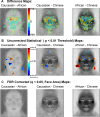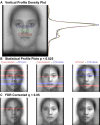Differences in Looking at Own- and Other-Race Faces Are Subtle and Analysis-Dependent: An Account of Discrepant Reports
- PMID: 26849447
- PMCID: PMC4744017
- DOI: 10.1371/journal.pone.0148253
Differences in Looking at Own- and Other-Race Faces Are Subtle and Analysis-Dependent: An Account of Discrepant Reports
Abstract
The Other-Race Effect (ORE) is the robust and well-established finding that people are generally poorer at facial recognition of individuals of another race than of their own race. Over the past four decades, much research has focused on the ORE because understanding this phenomenon is expected to elucidate fundamental face processing mechanisms and the influence of experience on such mechanisms. Several recent studies of the ORE in which the eye-movements of participants viewing own- and other-race faces were tracked have, however, reported highly conflicting results regarding the presence or absence of differential patterns of eye-movements to own- versus other-race faces. This discrepancy, of course, leads to conflicting theoretical interpretations of the perceptual basis for the ORE. Here we investigate fixation patterns to own- versus other-race (African and Chinese) faces for Caucasian participants using different analysis methods. While we detect statistically significant, though subtle, differences in fixation pattern using an Area of Interest (AOI) approach, we fail to detect significant differences when applying a spatial density map approach. Though there were no significant differences in the spatial density maps, the qualitative patterns matched the results from the AOI analyses reflecting how, in certain contexts, Area of Interest (AOI) analyses can be more sensitive in detecting the differential fixation patterns than spatial density analyses, due to spatial pooling of data with AOIs. AOI analyses, however, also come with the limitation of requiring a priori specification. These findings provide evidence that the conflicting reports in the prior literature may be at least partially accounted for by the differences in the statistical sensitivity associated with the different analysis methods employed across studies. Overall, our results suggest that detection of differences in eye-movement patterns can be analysis-dependent and rests on the assumptions inherent in the given analysis.
Conflict of interest statement
Figures






References
-
- Kealey R, Sekuler AB, Bennett PJ. Effects of viewing condition and age on the functionality of eye movements for face recognition memory. J Vis. 2008;8: 892–892. 10.1167/8.6.892 - DOI
-
- Cross JF, Cross J, Daly J. Sex, race, age, and beauty as factors in recognition of faces. Percept Psychophys. 1971;10: 393–396. 10.3758/BF03210319 - DOI
-
- Shepherd JW, Deregowski JB, Ellis HD. A Cross-Cultural Study of Recognition Memory For Faces. Int J Psychol. 1974;9: 205–212. 10.1080/00207597408247104 - DOI
Publication types
MeSH terms
Grants and funding
LinkOut - more resources
Full Text Sources
Other Literature Sources
Miscellaneous

